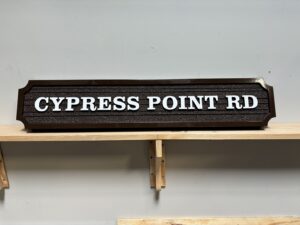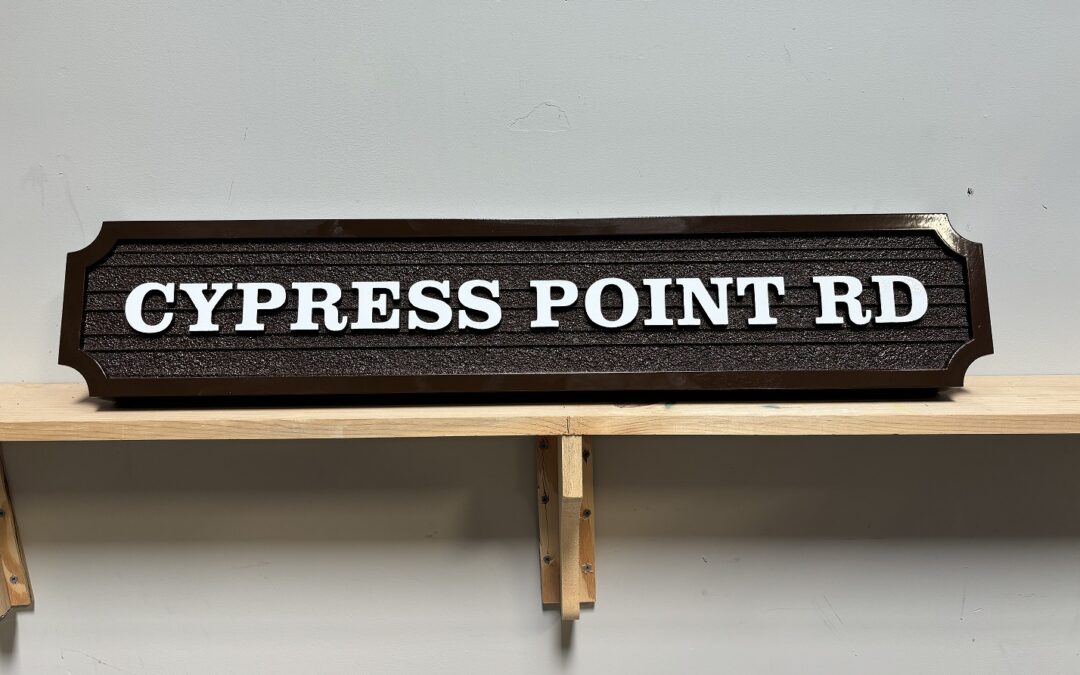Introduction: A New Shipment for Ocean Colony
 This week, SignWorks, in partnership with our wholesale partner, is shipping two new HDU street signs to the Ocean Colony Homeowner Association in Half Moon Bay, CA. These sandblasted signs showcase old-world craftsmanship and are sure to add a touch of elegance to the community. Let’s explore what makes these signs special and why HDU is a great choice for sign making.
This week, SignWorks, in partnership with our wholesale partner, is shipping two new HDU street signs to the Ocean Colony Homeowner Association in Half Moon Bay, CA. These sandblasted signs showcase old-world craftsmanship and are sure to add a touch of elegance to the community. Let’s explore what makes these signs special and why HDU is a great choice for sign making.
What is HDU?
Understanding HDU
HDU stands for High-Density Urethane. It is a type of material that is perfect for creating signs because it is lightweight, durable, and versatile. Here are some key points about HDU:
- Lightweight: HDU is much lighter than traditional wood, making it easier to handle and install.
- Durable: HDU is resistant to moisture, rot, and insects, which means it lasts longer than wood.
- Versatile: HDU can be carved, sandblasted, and painted to create beautiful, detailed designs.
The Craftsmanship of Sandblasted Signs
Old-World Techniques
Sandblasting is a technique that involves blasting sand at high speed to carve designs into the surface of the material. This method allows for intricate details and gives the signs a unique, textured look. Here’s how it’s done:
- Design Creation: First, a design is created and transferred onto the HDU surface.
- Sandblasting: The surface is then blasted with sand, carving out the design.
- Finishing Touches: Finally, the sign is painted and finished to protect it and enhance its beauty.
HDU vs. Traditional Wood
Comparing HDU with Redwood and Cedar
Redwood and cedar have been traditional choices for sign making for many years. However, HDU offers several advantages that make it a better choice in many cases. Let’s compare:
- Environmental Impact: HDU is more environmentally friendly because it doesn’t involve cutting down trees. Redwood and cedar, while beautiful, contribute to deforestation.
- Durability: HDU is more resistant to weather, moisture, and insects compared to redwood and cedar, which can rot and be damaged by pests.
- Weight: HDU is significantly lighter than both redwood and cedar, making it easier to work with and install.
- Consistency: HDU offers a more consistent texture and density, while wood can have knots and grain variations that affect the carving process.
Environmentally Friendly Qualities of HDU
Why HDU is Eco-Friendly
HDU is an excellent choice for environmentally conscious sign makers and customers. Here are some reasons why:
- No Trees Cut Down: HDU is made from synthetic materials, meaning no trees are harmed in its production.
- Recyclable: HDU can be recycled, reducing waste and the need for new raw materials.
- Longevity: Because HDU signs last longer, they don’t need to be replaced as often, leading to less environmental impact over time.
The Impact of HDU Signs in Ocean Colony
Enhancing the Community
The new HDU street signs for Ocean Colony Homeowner Association are not just functional but also enhance the beauty of the community. Here’s how:
- Aesthetic Appeal: The sandblasted HDU signs have a classic, elegant look that complements the natural beauty of Half Moon Bay.
- Durability: The signs will withstand the coastal weather conditions, ensuring they remain attractive and readable for many years.
- Identity and Pride: Custom Street signs help create a unique identity for the community, fostering a sense of pride among residents.
Conclusion: The Future of Sign Making
SignWorks is proud to provide high-quality, environmentally friendly HDU signs to communities like Ocean Colony. The use of HDU demonstrates our commitment to sustainability and craftsmanship. By choosing HDU over traditional woods like redwood and cedar, we help protect our forests while delivering durable and beautiful signs that stand the test of time.
We look forward to continuing our work with the Ocean Colony Homeowner Association and other clients who value quality, durability, and environmental responsibility in their signage.

